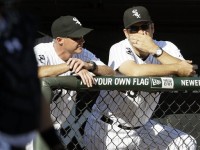Omar Minaya
Ten years ago, Omar Minaya had his second draft as the manager of the New York Mets. With the team having signed Pedro Martinez and Carlos Beltran in the offseason, they would not have a first round draft pick. In total, the Mets would draft 49 players, and they would be able to sign 35 of them. Of the 49 players drafted, six of the players would play in the major leagues. Here is review of those players that were drafted and played in the major leagues:
Kevin Mulvey, LHP (2nd Round, 62nd Overall)
Mulvey was a fairly well-regarded fastball-changeup pitcher out of Villanova, who shot through the Mets minor league system. In his first full professional season, he started in AA, and he finished the year with one start in New Orleans, which was then the Mets AAA affiliate.
In the offseason, Mulvey was a significant piece in the trade that brought Johan Santana to the Mets. Notably, he was the only player drafted by Minaya to be included in the deal.
Mulvey would not last long with the Twins. He spent a year and half with the team, and he made a very brief major league appearance with them in 2009. He would become the player to be named later in a trade in which the Twins acquired Jon Rauch to help them not only win the AL Central, but also to help them in the postseason.
Mulvey would not pitch well for the Diamondbacks. In 2009 and 2010, he would only make four starts and four relief appearances. He would go 0-3 with a 6.92 ERA and a 1.615 WHIP. In 2011, the Diamondbacks would designate him for assignment to remove him from the 40 man roster. A year later, he would be outright released.
Mulvey caught back on with the Mets in 2012, and he was assigned to AA Binghamton. After 13 relief appearances that saw him go 0-1 with a 5.59 ERA and a 1.707 WHIP, Mulvey retired from the game of baseball, and he returned to Villanova to be an assistant coach. On July 14, 2016, he was named the head coach of the Villanova Wildcats.
In total, Mulvey only started four games and made six relief appearances over three major league seasons. He finished with an 0-3 record, a 7.90 ERA, and a 1.756 WHIP.
Joe Smith, RHP (3rd Round, 94th Overall)
After losing Chad Bradford to free agency, the Mets decided the side winding Smith was ready to take over Bradford’s role in the bullpen.
Smith would pitch two seasons with the Mets making 136 appearances. In those games, he would go 9-5 with a 3.51 ERA and a 1.402 WHIP. While he could never match what Bradford did for the 2006 Mets, Smith was still a reliable bullpen arm so long as he was called to pitch to right-handed batters.
With the Mets bullpen falling to pieces during the 2008 season, the Mets sought a dominant reliever who could pitch in the eighth inning and who could be a reliable closing option in the event the Mets closer once again succumbed to injury. With that in mind, Smith was included as a part of a three-team deal that netted the Mets J.J. Putz. Ironically, it was Smith who would have the best career out of all the relievers in the deal.
During Smith’s five year tenure with the Indians, he got better and better each season as he got better and better pitching to left-handed batters. He went from being a reliever who got just righties out to an eighth inning set-up guy. Because of that, he got a big three year $15.75 million contract from the Angels when he hit free agency for the first time.
While Smith regressed a bit during his time with the Angels, he was still a very effective reliever. Because he is still a very useful reliever, the Chicago Cubs obtained him after the non-waiver trade deadline. Despite pitching well with a 2.51 ERA in 16 appearances for the Cubs, he was left off the postseason roster. Smith is due to be a free agent after the season.
So far in Smith’s 10 year career, he has averaged 64 appearances and 57 innings per season. He is 41-28 with 29 saves, a 2.93 ERA, and a 1.199 WHIP.
John Holdzkom, RHP (4th Round, 124th Overall)
Holdzkom was a high school pitcher with a big arm whose fastball could reach triple digits. Initially, he posted big strike out numbers in the minors before needing season ending Tommy John surgery in 2008. The surgery caused him to miss the entire 2009 season, and when he returned, he was never the same pitcher.
After six games in the rookie leagues in 2010, the Mets released him. Holdzkom would take a year off from baseball before signing a minor league deal with the Cincinnati Reds. He would struggle for two years in the Reds farm system before being released in June 2012.
From there, Holdzkom went to the Independent Leagues in the hopes of rekindling his hopes of becoming a major league pitcher. With his fastball returning, he was dominant with high strikeout numbers once again, and he caught the attention of the Pittsburgh Pirates, who offered him a minor league deal. In 2014, Holdzkom would actually appear in nine games for the Pirates pitching very well. In those games, he was 1-0 with a 2.00 ERA and a 0.667 WHIP.
Holdzkom would lose his fastball again, and he would never again be able to crack the Pirates major league roster. On the eve of Opening Day, he was released by the Pirates, and he was eventually signed to a minor league contract by the Chicago White Sox. While never appearing on an injury report anywhere, Holdzkom only made one appearance in 2016 for the White Sox rookie league affiliate in July. In two-third of an inning, he allowed four runs on three hits and two walks.
As for this moment, it is unknown what lies in the future of this 28 year old pitcher who is still looking to reclaim his fastball.
Daniel Murphy 3B (13th Round, 394th Overall)
Murphy is the best known player from the Mets 2006 draft. He got his start with the Mets in left field for a 2008 Mets team desperate for offense. Murphy hit well enough that he was named the Opening Day left fielder in 2009. That year it was apparent he was not an outfielder, and he began his transition to second base.
While there were some rough spots along the way, everything finally clicked for Murphy last postseason with him hitting home runs in six consecutive postseason games. These home runs were all the more notable when you consider Murphy hit them off Clayton Kershaw, Zack Greinke, Jon Lester, Jake Arrieta, and Kyle Hendricks. His key steal and home run in Game 5 helped propel the Mets to the NLCS, and in the NLCS he was the obvious choice for MVP.
He signed with the Nationals, and he went out and proved his postseason run was no fluke. Murphy hit .347/.390/.595 with 47 doubles, 25 homers, and 104 RBI. All these numbers were career bests. He led the National League in doubles, slugging, and OPS.
In his Mets career, Murphy hit .288/.331/.424 while averaging 33 doubles, nine homers, and 57 RBI per season. Among Mets second baseman, Murphy is the all-time leader in games, at-bats, runs, hits, doubles, RBI, and batting average. He is also ranked third overall for the most doubles by a player in a Mets uniform, and he is ranked eighth in batting average.
Tobi Stoner, RHP (16th Round, 484th Overall)
The German born Stoner was used as a starting pitching in the Mets minor league system. However, in his brief time with the major league club, he was used exclusively out of the bullpen. Between 2009 and 2010, Stoner made five appearances going 0-1 with a 3.97 ERA and a 1.412 WHIP.
After his big league call-ups, Stoner actually regressed. That could be in part due to bone spurs in his elbow he had to have removed prior to the 2011 season. Even with the removed bone spurs, Stoner could never get back to being the pitcher he was or who the Mets thought he could be, and he was released on the eve of the 2012 season. Stoner would pitch the 2012 season in the Independent Leagues. In 12 starts, he would have an 8.11 ERA, and his professional career was over after that season.
Josh Stinson, RHP (37th Round, 1,114th Overall)
Stinson was a high school pitcher with a mid 90’s fastball. As he did not truly develop his secondary pitches, he became a bullpen arm. With a his live arm, he got called-up in 2011, at the age of 23, and pitched in 14 games with the Mets recording a 6.92 ERA and a 1.615 WHIP.
The Mets relased him before the 2012 season, and he was claimed by the Brewers. He pitched mostly in the minors for the Brewers. Stinson did get a brief call-up where he actually pitched well. Despite his success in a small sample size, he was released before the 2013 season, and he was eventually picked up by the Orioles. He made 19 appearances with the Orioles, pitching to a 4.50 ERA, before he was granted free agency. Stinson signed a minor league deal with the Pittsburgh Pirates, and he would not make it to the majors in the 2014 season. The Pirates released him at the end of the year.
In the 2015 season, Stinson pitched for the Kia Tigers of the Korean Leauges. In 30 starts and two relief appearances, Stinson was 11-10 with a 4.96 ERA and a 1.521 WHIP. No one signed him to a professional contract to pitch in 2016. According to Stinson’s Twitter account, the 28 year old still considers himself a free agent pitcher.
Vic Black, RHP (41st Round, 1,234th Overall)
The Mets drafted Black out of high school, but he would not sign a deal with the Mets. Rather, he attended Dallas Baptist University, and he re-entered the draft in 2009 where the Pittsburgh Pirates would draft him in the first round (49th overall). The Mets would acquire Black in 2013 as part of the trade that sent John Buck and Marlon Byrd to the Pittsburgh Pirates in exchange for Black and Dilson Herrera.
In 2014, Black seemed to have a breakout season for the Mets. He began to harness his high 90s fastball, and as a result, he was becoming a reliable bullpen arm. Unfortunately, Black would land on the disabled list with a herniated disc in his neck. When he tried to pitch through it, he eventually developed a shoulder strain. He was first shut down, and then designated for assignment in the offseason.
While Black elected free agency, he hoped that he could re-sign with the Mets. Neither the Mets nor any other major league team were interested in his services. Black has not pitched in professional baseball in two years. At the moment, it is unknown if he will be able to ever pitch again.
Johnny Monell, C (49th Round, 1,463rd Overall)
Like Black, Monell did not sign a contract with the Mets instead choosing to re-enter the draft at a later date. He would be drafted by the San Francisco Giants in the 30th round in the following draft.
From there, Monell has bounced around from organization to organization. Finally, in 2014, he returned to the same Mets organization that had drafted him eight years prior. Due to injuries to Travis d’Arnaud and the ineffectiveness of both Kevin Plawecki and Anthony Recker, Monell would be called-up to the Mets in 2015, and he would play in 27 games hitting .167/.231/.208 with two doubles and four RBI. Monell would be sent back down to AAA where he would remain for the 2015 season.
The Mets would remove him from the 40 man roster after the 2015 season, and Monell would agree to return to the Mets. Monell spent the entire 2016 season playing for the Las Vegas 51s. He hit .276/.336/.470 with 22 doubles, one triple, 19 homers, and 75 RBI. With Plawecki being sent down in favor of Rene Rivera, Monell became the backup catcher. In order to get him into the lineup more, Monell saw some additional time at first base. Monell finished the year tied for the team lead in homers and third in RBI.
At this point, it is not known if the Mets intend to bring back the 30 year old catcher to play for the 51s again in the 2017 season.
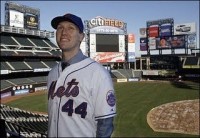
This isn’t a criticism of Sandy Alderson and his staff. This isn’t an issue of this front office being stingy or refusing to go the extra mile to get the player. It’s just that historically the Mets typically do not outbid teams when it comes to the big free agent.
That’s not to say the Mets don’t sign free agents. Obviously, they do. They’ve also overspent and spent big money on some free agents. It’s just that they don’t typically win bidding wars. They especially don’t do so when a big market team is also bidding on the same player. My personal feelings aside, I just don’t see how the Mets outbid everyone for Ben Zobrist. Here are the instances where the Wilpon led Mets outbid everyone for a high priced player:
Jason Bay
In 2009, the Mets signed Jason Bay. In some ways it could be interpreted as the Mets won a bidding war and in others it could be seen as the Red Sox moved on to other players.
Fact is the Red Sox essentially had a four year $60 million contract offer, which may or may not have been pulled due to medical concerns. You can never fully trust Boston’s statements when a player leaves. The fact is the Mets had to offer $6 million extra to bring Bay to New York. The fact also remains the Mets went after Bay instead of going after the much better and much more expensive Matt Holliday.
This isn’t about how Bay fared with the Mets as no one could have reasonable predicted what happened next. This is about the Mets outbidding the Red Sox for a player only after deciding to not even get involved in the bidding for the more expensive, better player.
Carlos Beltran
The Carlos Beltran story is an interesting one. Like Bay, it was also a move made under the Omar Minaya regime.
What’s most interesting about this was the Yankees never got involved in the bidding despite Beltran all but begging them to offer him a contract. Furthermore, the Astros had a limited window to negotiate with Beltran. Under the old free agency rules, the Astros only had until January 7th to re-sign him. If they didn’t, they were barred from re-signing him until May 1st.
The Mets went above and beyond then in Minaya’s first year as GM. The Mets signed Beltran to a then whopping seven year $119 million contract. It was a real power move that the Mets haven’t typically been the Mets strength. There was one other move in 2005 that was uncharacteristic.
Pedro Martinez
Like Bay, the Mets were able to outbid the Red Sox for Pedro Martinez because the Red Sox drew a line in the sand in a player they knew/suspected had questionable medicals. Unlike Bay, the Mets clearly outbid the Red Sox.
The Red Sox thought they had Pedro re-signed giving him the extra year he wanted. The Mets just gave that extra year and money no one thought Pedro could/should get. Like Beltran, this was part of Minaya’s reshaping of the Mets. It’s truly interesting the major deals happened in 2005 when Minaya took over the team. In some ways, it makes you question how much the Madoff Ponzi fallout affected the Mets.
Yes, it clearly limited payroll. However, after 2005, the Mets never truly went the extra mile in seeking to acquire the top free agent on the market. They were initially rebuffed by Carlos Delgado (until he was later obtained via trade). They did give a huge contract to Johan Santana in the wake of the 2007 collapse. However, that was part of a trade and not part of a free agent bidding process.
So while the Mets have at times spent money pre-Madoff, it appears the team does not usually win these free agent bidding contests. Additionally, after 2005, the team has typicall backed off the top free agent on the market that would/could fulfill a need like Jason Heyward.
In any event, it appears if history repeats itself here, the Mets will not get Zobrist. This may or may not be due to the budget. It may due more to an organizational philosophy that was in place before Sandy Alderson ever became the GM.
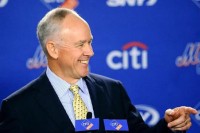
Here’s a question for you. If you had a GM that gave a bad contract to a 35 year old, forfeiting a pick in the process, and depleted it’s farm system of its top end starting pitching prospects for rentals, what would you call that GM? Apparently, you call Sandy Alderson the Executive of the Year.
Before proceeding, I’d like to note Alderson has generally done a good job with the Mets. The R.A. Dickey trade was a stroke of genius. However, that happened three years ago, and this is a 2015 award.
Alderson made two major league free agent signings for the 2015 season. The first was Michael Cuddyer. It was immediately panned by everyone. Alderson was out-maneuvered there by the Rockies of all organizations. With the Mets all but declaring they were signing David Wright‘s friend, the Rockies gave Cuddyer a qualifying offer. The Mets then gave Cuddyer a two year $21 million contract. Cuddyer was hurt, and he regressed as 35 year old players do. He’s now a $12.5 million bench player.
The other free agent deal was John Mayberry, Jr. Mayberry hit .164/.227/.318. He was released at the end of July. Overall, Alderson’s free agent acquisitions were complete busts.
His trades weren’t much better. Do you realize for a team touted with organizational starting pitching depth, Alderson depleted much of it. He traded eight minor league arms in total. For all the pitchers that were traded, Addison Reed is the only player the Mets could keep in 2016. By the way, Reed is a non-tender candidate.
Yes, the Mets made the World Series. They also lost it. For all the moves and sacrificing the future, the Mets still fell short. Further, it does not appear the moves generated enough revenue to sufficiently increase payroll. In the end, the Mets have up two big pitching prospects for rentals. If you’re saying it was worth it, I ask you if John Smoltz was worth it?
In 1987, Smoltz was traded for Doyle Alexander. Alexander went 9-0 with a 1.53 ERA for the Tigers. His fantastic run certainly mirrors the run Yoenis Cespedes had this year. Like the Mets, the Tigers won their division. Like the Mets, the Tigers didn’t win the World Series. The Tigers lost out on a Hall of Fame career. Time will only tell with Michael Fulmer. However, we do know he’s a highly rated prospect the Tigers believe can contribute very soon.
It’s the reason I said it was a bad trade from the beginning. It’s even worse when you consider the Tigers had to trade Cespedes because they were about to lose him for nothing.
Then there’s the issue of giving up another well regarded prospect in Casey Meisner for Tyler Clippard. Clippard was a rental. Yes, Clippard was terrific early on with the Mets, and he helped the Mets win the division. Addison Reed was even better, and the Mets obtained him for much less. Again, this was a bad trade.
No, Alderson won this award for his earlier work and the system built by Omar Minaya. Alderson weakened the farm system in 2015, and he may now need to trade away major league talent rather than minor leaguers to improve the team in 2016. After all his moves, the Mets still don’t have a shortstop. There may also be new holes in center and at second.
Alderson has had a good run here, but he was not good in 2015. He certainly wasn’t the best executive in 2015. Unfortunately, this should bear out in the oncoming years.
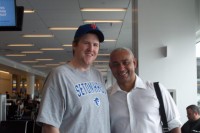
Look, this is Sandy Alderson’s team. He decided to keep the players he kept and trade the players he traded. He pulled off the trades and signed the free agents. However, he was able to do a lot of what he did because he was left with good players after Omar Minaya was terminated.
Here are the players in the 40 man roster who have a link to Omar Minaya (asterisked players are players obtained with players combined by Minaya and Alderson):
Jerry Blevins – obtained for 2010 draft pick Matt den Dekker.
Eric Campbell – 2008 draft pick.
Darrell Ceciliani – 2009 draft pick.
Travis d’Arnaud – part of the R.A. Dickey trade. Dickey was a free agent signing. Josh Thole was a 2005 draft pick. Mike Nickeas was initially obtained by trade in 2006.
Jacob deGrom – 2010 draft pick.
Lucas Duda – 2007 draft pick.
Jeurys Familia – 2007 amateur free agent signing.
Wilmer Flores – 2007 amateur free agent signing.
Erik Goeddel – 2010 draft pick.
Matt Harvey – 2010 draft pick
Dilson Herrera* – part of Marlon Byrd/John Buck trade. Buck was part of the Dickey trade (see d’Arnaud).
Juan Lagares – 2006 amateur free agent signing.
Steven Matz – 2009 draft pick.
Jenrry Mejia – 2007 amateur free agent signing.
Akeel Morris -2010 draft pick.
Daniel Murphy – 2006 draft pick.
Bobby Parnell – 2005 draft pick.
Addison Reed* – obtained in exchange for Matt Koch and Miller Diaz (signed by Mets in 2009).
Hansel Robles – 2008 amateur free agent.
Noah Syndergaard – part of Dickey trade (see d’Arnaud).
Ruben Tejada – 2006 amateur free agent.
Again, these players are in the roster because Alderson kept them. The decision of who to keep and trade is important. That is what makes them Alderson’s players and team. Additionally, while It was Alderson that hired Terry Collins, it was Minaya who brought him into the Mets organization.
However, it is important to truly acknowledge Minaya’s role, especially when he has been unfairlyand wrongly marginalized.
You see I was on the same Jet Blue flight as Omar Minaya. The photo with this post was Minaya and me in the terminal before the flight. He was accessible to Mets fans who wanted to shake his hand and take a picture. No one, and I mean no one, had the “courage” to mock him on the flight.
Additionally, this should dispel the notion that Minaya left the Mets with a depleted farm system. On the contrary, he built a strong farm system that helped make up this team. Minaya had his faults, and he probably deserved to be fired when he was. That doesn’t mean we should ignore his work.
It doesn’t mean that we shouldn’t extend our gratitude to him for what he left behind.
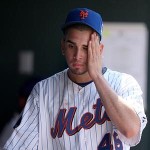
After Duaner Sanchez‘s infamous cabride, Omar Minaya made a trade to acquire Roberto Hernandez and Oliver Perez. While the thought process might have been to get another reliever, it was Perez who was pressed into action.
At first, Perez seemed like an asset for the future. More likely, he was a throw-in. However, Pedro Martinez‘s season ended in September because he needed rotator cuff surgery. El Duque was injured right before Game One of the NLDS. Steve Trachsel was horrid in the NLDS and the NLCS. The Mets had no option but to press Oliver Perez into action.
With the Mets down 2-1 in the NLCS, Perez pitched reasonably well. Through five innings he only let up three runs. He started to lose it in the sixth, but that was only after the Mets expanded their lead to 11-3. Then came that epic and tragic Game Seven. Perez was pressed into action again. This time it was on three days rest.
In Game Seven, he allowed one run over six innings. He was terrific that night, but he was mostly aided by Endy Chavez:
By the way, I was there. I’ve never see Shea like that. For all the good Citi Field has to offer, it will never be like it was at Shea after that catch. I don’t need to continue as to what happened next.
In 2007, Perez went 15-10 with a 3.56 ERA. In 2008, he wasn’t as good, but he was effective going 10-7 with a 4.22 ERA. He started the last game at Shea with another collapse on hand. He gave the Mets 5.1 innings with two earned allowed. He kept the Mets in the game allowing Carlos Beltran to tie the score in the sixth on a two run homerun. The season effectively ended when Jerry Manuel brought in Scott Schoeneweis.
Imagine if that was the end of Oliver Perez. He would’ve been remembered as a gamer. He would’ve been remembered for two decent seasons. Unfortunately, he signed that contact, and he was terrible. That was the lasting memory; not his clutch performances.
It’s a shame. He could’ve been beloved by Mets fans forever instead of the villain he is. While good-byes are hard, sometimes it’s harder when the player stats too long.
Did you ever hear of the saying, the more things change the more they stay the same? The saying drives me absolutely nuts. Inherently, something that is static cannot also be idle at the same time. However, for the first time I am starting to understand this saying.
I believe this season is starting to resemble 2005. Sure there was some optimism before that season with the signings of Carlos Beltran and Pedro Martinez. This was also going to be the first full season David Wright and Jose Reyes were going to play together. That team also had some holes: Doug Mientkiewicz had a great glove but not the bat to play 1B, Kaz Matsui was being shifted to play 2B after he showed he couldn’t play SS the prior year, and let’s not forget the closer was Braden Looper in a largely ineffective bullpen. However, I don’t know of anyone that expected the Mets to realistically make the playoffs that year.
At that point, the Mets fans were suffering. In 2001, the Mets rallied around the city, but they fell short of making the playoffs in an otherwise disappointing season. In 2002, we watched Steve Phillips attempt to recreate the team as an offensive juggernaut with the likes of Mo Vaughn, Roberto Alomar, Jeromy Burnitz, and Roger Cedeno. This lead to three years of just bad baseball. Now, the Mets fans were clamoring for a move to be made. We wanted to see Piazza go out on his last year with the Mets with a winner. At the Trading Deadline, the Mets found themselves only 4 games out of the Wild Card.
However, Omar Minaya stayed the course. The Mets made no trades. He kept his bullets for the offseason. If you recall, that was a magical offseason with the additions of Paul LoDuca, Carlos Delgado, Jose Valentin, Xavier Nady, Endy Chavez, Julio Franco, Pedro Feliciano, Duaner Sanchez, John Maine, Jorge Julio (was was then traded in season for El Duque), Darren Oliver, and Billy Wagner. Omar showing restraint permitted the Mets to build that great 2006 team the fans loved.
Now, Mets fans have been suffering longer than they were in 2005, and they are begging for just one bat (which I don’t think will do the trick). While Mets fans were disappointed in 2005, I don’t remember them being a distraught as they are now. I think the difference is trust. We trusted that ownership and Omar would spend the money to get the players that were needed. In fact, they just come off of a spending spree that netted Pedro and Beltran. Now, fans don’t trust that ownership will spend the money. I believe this is the trust gap that is the biggest sense of frustration with this team.
It’s a shame too because I remember 2005 being a fun season. So far, I think 2015 has been gut-wrenching with all the tight, low-scoring games. My only hope is that if the Mets don’t make a move now, they have a plan for what can be realistically accomplished this summer. There will be LF available who can really help the team in the short term, but the market is scarce on middle infielders. My fingers are crossed. I want to be able to go to a playoff game with my father and son.
